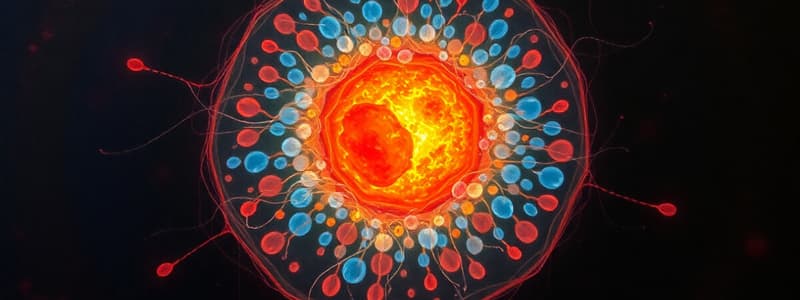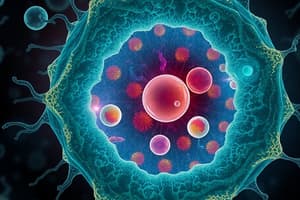Podcast
Questions and Answers
What are the primary functions of the nucleolus within the nucleus?
What are the primary functions of the nucleolus within the nucleus?
- Production of proteins using messenger RNA
- Regulation of nuclear pore activity
- Synthesis of ribosomal RNA (correct)
- Packaging DNA for cell division
What is primarily responsible for the rigidity and shape of plant cells?
What is primarily responsible for the rigidity and shape of plant cells?
- Cell membrane
- Cellulose (correct)
- Plasma proteins
- Cytoplasm
What is the main structural feature shared by the inner and outer nuclear membranes?
What is the main structural feature shared by the inner and outer nuclear membranes?
- They are fused at nuclear pore sites
- They are both composed of a double phospholipid bilayer (correct)
- They both contain ribosomal RNA
- They are both made up of a single phospholipid layer
Which of the following structures is known for protecting cells from lysing in hypotonic solutions?
Which of the following structures is known for protecting cells from lysing in hypotonic solutions?
Which statement accurately describes mitochondria in relation to cytoplasmic volume?
Which statement accurately describes mitochondria in relation to cytoplasmic volume?
What role does NADPH play in the context of oxidative stress in red blood cells?
What role does NADPH play in the context of oxidative stress in red blood cells?
Which characteristic distinguishes the nucleolus from other components in the nucleus?
Which characteristic distinguishes the nucleolus from other components in the nucleus?
Which pathway involves the transport of whole cells to lysosomes?
Which pathway involves the transport of whole cells to lysosomes?
What is the primary role of endosomes in cellular processes?
What is the primary role of endosomes in cellular processes?
Which type of endoplasmic reticulum is primarily involved in lipid synthesis?
Which type of endoplasmic reticulum is primarily involved in lipid synthesis?
What role does the nuclear envelope play in cellular function?
What role does the nuclear envelope play in cellular function?
What consequence may arise due to the peroxidation of membrane lipids in erythrocytes?
What consequence may arise due to the peroxidation of membrane lipids in erythrocytes?
What is the primary energy production process that occurs in mitochondria?
What is the primary energy production process that occurs in mitochondria?
Which protein is specifically associated with the endocytic pathway during membrane invagination?
Which protein is specifically associated with the endocytic pathway during membrane invagination?
What is the primary function of ribosomes in a cell?
What is the primary function of ribosomes in a cell?
Which enzyme compartment is responsible for degrading proteins and nucleic acids?
Which enzyme compartment is responsible for degrading proteins and nucleic acids?
Which feature of the nucleus is responsible for defining its structure?
Which feature of the nucleus is responsible for defining its structure?
How does the endoplasmic reticulum function analogously to a road system?
How does the endoplasmic reticulum function analogously to a road system?
How do mitochondria relate to chloroplasts in terms of their functions?
How do mitochondria relate to chloroplasts in terms of their functions?
What characterizes the autophagic pathway in cells?
What characterizes the autophagic pathway in cells?
Which of these can trigger a hemolytic crisis in susceptible individuals?
Which of these can trigger a hemolytic crisis in susceptible individuals?
How do cell membranes contribute to cellular functions apart from surrounding the cell?
How do cell membranes contribute to cellular functions apart from surrounding the cell?
Which component of the nucleus primarily contains regions of heterochromatin?
Which component of the nucleus primarily contains regions of heterochromatin?
What components make up ribosomes?
What components make up ribosomes?
What is the role of a coated pit in endocytosis?
What is the role of a coated pit in endocytosis?
What distinguishes the late endosomes from early endosomes in cellular trafficking?
What distinguishes the late endosomes from early endosomes in cellular trafficking?
What is the impact of glutathione peroxidase in red blood cells?
What is the impact of glutathione peroxidase in red blood cells?
In cases of hemolytic anemia, what is a likely contributing factor?
In cases of hemolytic anemia, what is a likely contributing factor?
Which of the following conditions is most frequently associated with hemolysis crisis?
Which of the following conditions is most frequently associated with hemolysis crisis?
What is the primary characteristic that differentiates the outer membrane of a mitochondrion from the inner membrane?
What is the primary characteristic that differentiates the outer membrane of a mitochondrion from the inner membrane?
During the process of apoptosis, what role does cytochrome c play?
During the process of apoptosis, what role does cytochrome c play?
What process do mitochondria utilize for self-replication?
What process do mitochondria utilize for self-replication?
Which of the following statements about mitochondrial DNA (mtDNA) is true?
Which of the following statements about mitochondrial DNA (mtDNA) is true?
What is a significant structural feature of the inner mitochondrial membrane that contributes to its function?
What is a significant structural feature of the inner mitochondrial membrane that contributes to its function?
What is the major function of acetyl-CoA in relation to mitochondrial processes?
What is the major function of acetyl-CoA in relation to mitochondrial processes?
What is a primary mechanism for directing proteins synthesized on bound ribosomes to the endoplasmic reticulum (ER)?
What is a primary mechanism for directing proteins synthesized on bound ribosomes to the endoplasmic reticulum (ER)?
Which of the following statements about proteins synthesized on free ribosomes is accurate?
Which of the following statements about proteins synthesized on free ribosomes is accurate?
In the process of glycosylation, which structure modifies proteins after they leave the ER?
In the process of glycosylation, which structure modifies proteins after they leave the ER?
Which type of secretion describes proteins that are constantly released from the cell?
Which type of secretion describes proteins that are constantly released from the cell?
For lysosomal enzymes, which modification occurs when they reach the Golgi complex?
For lysosomal enzymes, which modification occurs when they reach the Golgi complex?
What is critical for a protein synthesized on a free ribosome to be directed to the mitochondria?
What is critical for a protein synthesized on a free ribosome to be directed to the mitochondria?
Where do proteins synthesized on bound ribosomes first travel after leaving the ER?
Where do proteins synthesized on bound ribosomes first travel after leaving the ER?
What role does the signal receptor protein play in the targeting of proteins to the ER?
What role does the signal receptor protein play in the targeting of proteins to the ER?
Which cellular process relies on transport vesicles for movement from the ER?
Which cellular process relies on transport vesicles for movement from the ER?
What is the function of the trans Golgi network?
What is the function of the trans Golgi network?
Flashcards are hidden until you start studying
Study Notes
The Nucleus
- The nucleus is the largest organelle in animal cells.
- It is surrounded by a double membrane called the nuclear envelope.
- The nuclear envelope is composed of two phospholipid bilayers that contain different types of proteins.
- The inner and outer nuclear membranes are fused at nuclear pores, which allow materials to pass between the nucleus and the cytosol.
- The inner nuclear membrane defines the nucleus.
- The outer nuclear membrane is continuous with the rough endoplasmic reticulum.
The Nucleolus
- The nucleolus is a nuclear subcompartment where most of the cell's rRNA is synthesized.
- It is not surrounded by a membrane.
Chromosomes
- The nucleus is filled with chromatin, which is composed of DNA and proteins.
- In dividing cells, the nucleus is the site of mRNA and tRNA synthesis.
Mitochondria
- Mitochondria are surrounded by a double membrane and are responsible for generating ATP through the oxidation of glucose and fatty acids
- Mitochondria are found in both plant and animal cells and are the site of cellular respiration.
- Most eukaryotic cells contain many mitochondria, which can make up to 25% of the cell's cytoplasm.
- Mitochondria are among the largest organelles, second only to the nucleus, vacuoles, and chloroplasts.
- Mitochondria contain their own DNA.
- The inner membrane of mitochondria is extensively folded to provide a large surface area for ATP synthesis.
- Enzymes in the inner mitochondrial membrane and matrix carry out the terminal stages of sugar and lipid oxidation, which is coupled to ATP synthesis.
Cell Walls
- Cell walls are mainly built of cellulose.
- They determine cell shape and provide rigidity to cells.
- Cell walls are much stronger than cell membranes and protect cells from lysing (exploding) in hypotonic solutions.
Membranes
- Cell membranes surround cells and regulate the entrance and exit of substances, maintaining internal balance and contributing to cell signaling and adhesion.
- Cell membranes protect the internal cell from external forces.
Endosomes
- Endosomes internalize plasma-membrane proteins and soluble materials from the extracellular medium and sort them back to the membranes or to lysosomes for degradation.
The Endoplasmic Reticulum (ER)
- There are two types of ER: smooth ER and rough ER.
- Smooth ER synthesizes lipids and detoxifies certain hydrophobic compounds.
- Rough ER functions in the synthesis, processing, and sorting of secreted proteins, lysosomal proteins, and certain membranes.
- The ER makes up approximately half of all the membranous tissue of the cell and is the site of membrane and protein synthesis.
Ribosomes
- Ribosomes are the site of protein synthesis.
- They can be found free in the cytoplasm, attached to the rough endoplasmic reticulum, or associated with the nucleus.
- They are not membrane-bound and are made of RNA and protein.
- Ribosomes bring together RNA and amino acids to assemble proteins.
Trafficking of Proteins Synthesized on Bound or Free Ribosomes
- Proteins synthesized on bound ribosomes are trafficked to the ER, Golgi complex, lysosomes, and can be secreted from the cell.
- Proteins synthesized on free ribosomes remain in the cytosol, unless they contain a specific tag that directs them to the nucleus, mitochondria, or peroxisomes.
Lysosomal Enzymes
- Lysosomal enzymes are glycosylated and modified in a specific way.
- Mannose residues in their oligosaccharide chains are phosphorylated.
Mitochondria Membranes
- Mitochondria have two membranes: an outer membrane and an inner membrane.
- The outer membrane is highly permeable and composed of half lipid and half protein.
- The inner membrane is much less permeable, composed of 20% lipid and 80% protein, and is extensively folded.
ATP
- ATP is created in the mitochondria and used for energy by the cell.
- It is the universal "currency" of chemical energy.
- In animal and plant cells, most ATP is produced by large molecular machines located in mitochondria and chloroplasts.
Apoptosis
- When apoptosis is stimulated, proapoptotic proteins insert into the mitochondrial membrane, forming pores.
- Cytochrome c can then leave the intermembrane space of the mitochondria and enter the cytosol.
- Cytochrome c in the cytosol stimulates a cascade of biochemical events that result in apoptotic death of the cell.
Mitochondria and Disease
- Mutations or errors in mitochondrial genes can result in disease.
- Most mitochondrial proteins are encoded by the genomic DNA of the cell's nucleus.
Mitochondria Replication
- Mitochondria replicate or divide by fission, similar to bacteria.
- Mitochondria are believed to have originated from bacteria that were engulfed by ancestral eukaryotic cells.
- In most multicellular organisms, mitochondrial DNA (mtDNA) is maternally inherited.
Studying That Suits You
Use AI to generate personalized quizzes and flashcards to suit your learning preferences.



